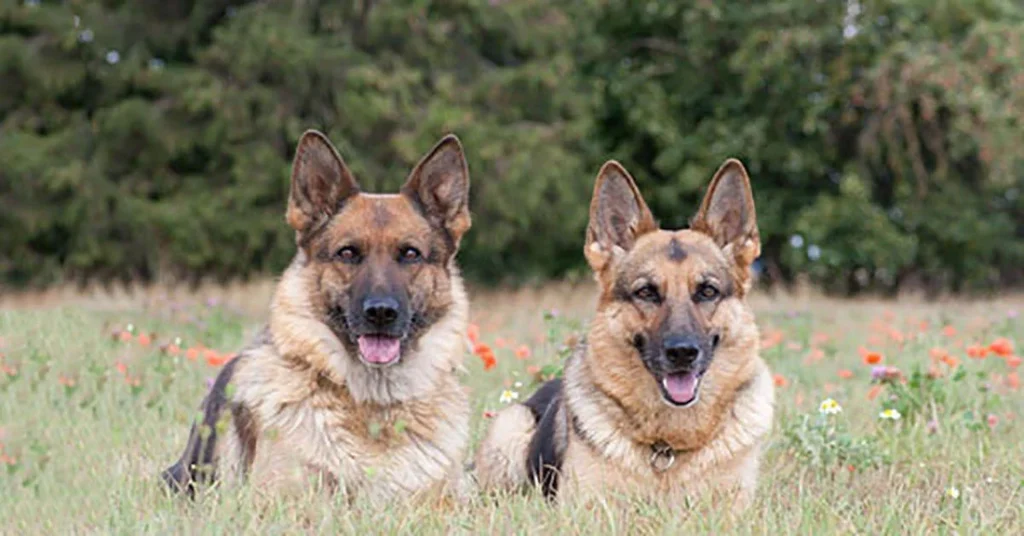Male German Shepherds are larger and protective, while females are nurturing, focused, and easier to train. Both require exercise, training, and socialization to thrive as loyal, intelligent companions.
German Shepherds are one of the most well known and bendy dog breeds worldwide. Known for their intelligence, loyalty, and protective instincts, they make excellent pets, working dogs, and family companions.
However, when deciding to bring a German Shepherd into your home, many prospective owners wonder about the difference between female and male German Shepherds. Understanding these differences is crucial in choosing the right dog for your lifestyle and household.
Physical Differences Between Female and Male German Shepherds
Size and Weight
One of the most noticeable differences between female and male German Shepherds is their size. Males are generally larger, standing between 24 to 26 inches tall and weighing 65 to 90 pounds. Females, on the other hand, are slightly smaller, measuring 22 to 24 inches in height and weighing 50 to 70 pounds.
This size difference can influence your decision if you are looking for a dog for protection work, agility, or family companionship. While males may appear more imposing, females often have a more agile and compact build, making them better suited for some activities.
Physical Appearance
Males tend to have broader heads, thicker necks, and a more muscular physique. Females, however, usually have a sleeker and more refined appearance. These physical traits contribute to how each gender presents itself, which can affect their work roles or family presence.
Temperament Differences

Personality Traits
When it comes to temperament, there are subtle yet significant differences between female and male German Shepherds. Males are often more confident and assertive. They may exhibit a protective instinct over their territory and family, which can be an advantage if you are searching for a defence dog.
Females, on the other hand, are generally more nurturing and attentive. They often bond more closely with family members and may be easier to train due to their higher focus and patience.
Behavior Towards Family
Female German Shepherds are usually more empathetic and responsive to children, making them excellent family pets. Males may sometimes be more dominant and require consistent training and socialization to ensure they are well mannered around children and other pets.
Training and Intelligence
German Shepherds, regardless of gender, are highly intelligent and trainable. However, there are slight differences in how males and females respond to training.
- Male German Shepherds: Males may display stubbornness at times, requiring patience and consistent commands during training. Their confidence can sometimes be mistaken for disobedience.
- Female German Shepherds: Females often excel in obedience training and learning new commands faster due to their attentiveness and focused nature.
Both genders thrive in structured environments with clear rules, but understanding these differences can make training more efficient.
Energy Levels and Exercise Needs
Males tend to have slightly higher energy levels and may require more vigorous exercise, including running, agility training, and mental stimulation. Females are energetic as well but may be more content with moderate exercise, long walks, and interactive play.
Regular physical activity is crucial for both genders to prevent boredom, destructive behavior, and obesity. Incorporating mental stimulation, such as puzzle toys or training sessions, will help maintain a healthy and happy German Shepherd.
Health Considerations
Both male and female German Shepherds are prone to some common health issues, such as hip dysplasia, elbow dysplasia, and degenerative myelopathy. However, females may experience additional considerations related to reproduction, including heat cycles and the risk of pyometra (uterine infection).
Males may exhibit more dominant behaviors during adolescence, including marking territory and challenging other dogs. Neutering or spaying can help manage these behaviors and improve overall health.
Socialization and Behavior Around Other Pets

Socialization is essential for both male and female German Shepherds.
- Male German Shepherds: They may show more dominance toward other dogs, especially males. Early socialization helps prevent aggressive tendencies and encourages calm interactions.
- Female German Shepherds: Generally more social and less territorial, females often integrate better with other pets in the household.
Understanding these tendencies can guide your decision, especially if you have other dogs or pets at home.
Choosing the Right Gender for Your Lifestyle
Selecting between a female and male German Shepherd ultimately depends on your lifestyle, family structure, and purpose for the dog.
- Choose male German Shepherds if you desire a strong, confident dog for protection, outdoor activities, or advanced training.
- Choose female German Shepherds if you prefer a nurturing, attentive companion who bonds closely with family members and adapts well to personal family life.
Regardless of gender, every German Shepherd is unique, and individual temperament may vary. Spending time with puppies before adoption can help you make the best choice.
FAQs:
1. Is it better to get a male or female German Shepherd?
It depends on your lifestyle. Males are larger and protective, while females are more nurturing, focused, and easier to train for families.
2. Which gender of German Shepherd is more protective?
Male German Shepherds tend to be more protective due to their dominant and confident nature, but both genders can guard effectively with proper training.
3. Which German Shepherd is easier to train, male or female?
Female German Shepherds are often easier to train as they are more attentive, focused, and responsive, though males are equally intelligent with consistent training.
4. How to identify male and female German Shepherds?
Males are generally larger, muscular, and broader headed, while females are smaller, leaner, and may have a more subtle look and mild demeanor.
5. Are male German Shepherds more aggressive than females?
Males may show more dominant behavior, but with proper training and socialization, both male and female German Shepherds are friendly and safe.
6. Which gender is easier to train, male or female?
Female German Shepherds are generally more attentive and focused, making training slightly easier, though both genders are highly intelligent.
7. Are female German Shepherds better with children?
Yes, females are often more nurturing, patient, and empathetic, making them excellent companions for families with children.
Conclusion:
Understanding the difference between female and male German Shepherds helps you choose the right companion. Males are protective, confident, and larger, while females are nurturing, attentive, and easier to train. Both genders require proper exercise, socialization, and consistent training to thrive. Your choice should align with your lifestyle, family dynamics, and purpose for the dog. By considering these factors, you can ensure a harmonious relationship and enjoy the loyalty, intelligence, and companionship that German Shepherds bring to any home.
Related Post:
- Do Hotels Allow Cats – Complete Guide for Traveling Cat Owners!
- Canned Cat Food For Diabetic Cats – Complete Guide!
- Low Carbohydrate Canned Cat Food – Healthy Choice for Your Feline!
- How To Get Rid Of Cat Poop Smell – 10 Expert Tips That Work!
- Cat Broken Tooth – Symptoms, Causes, and Treatment Guide!
